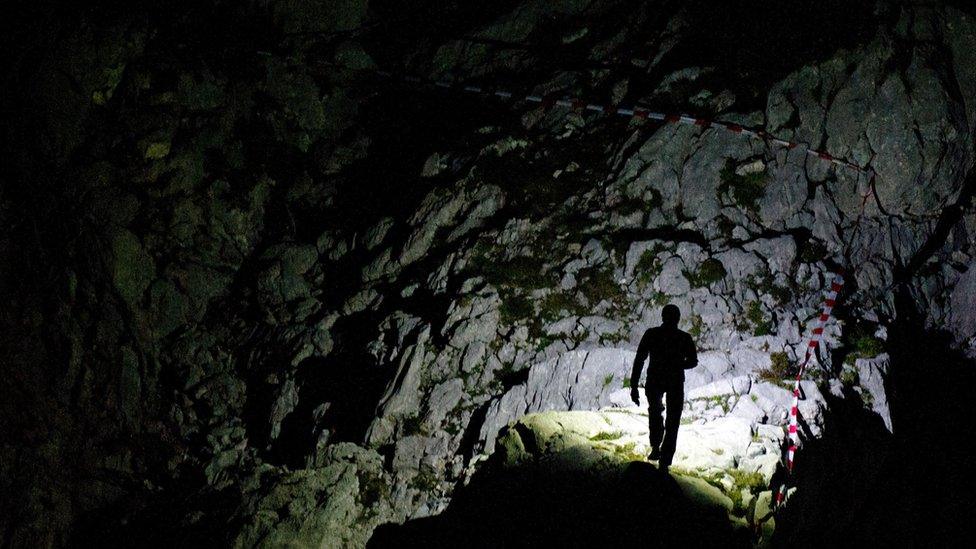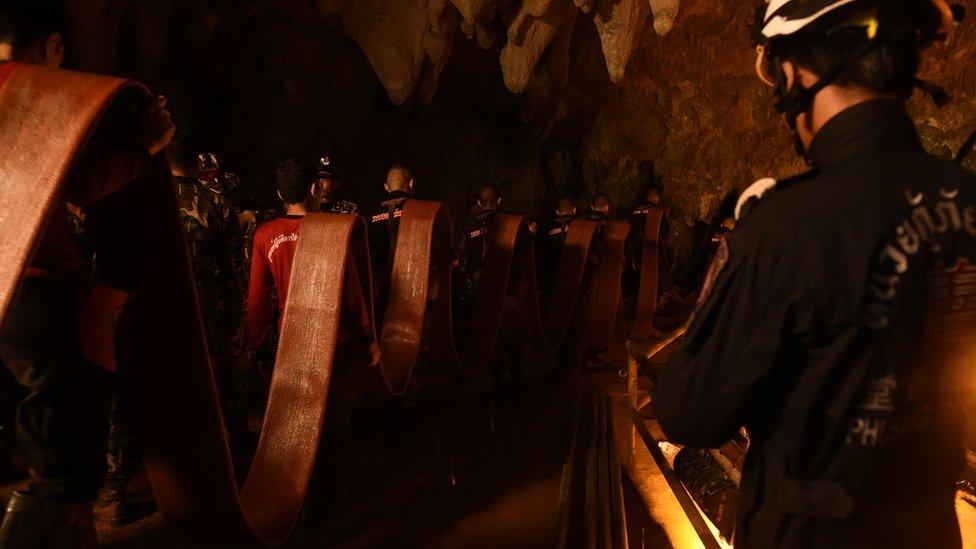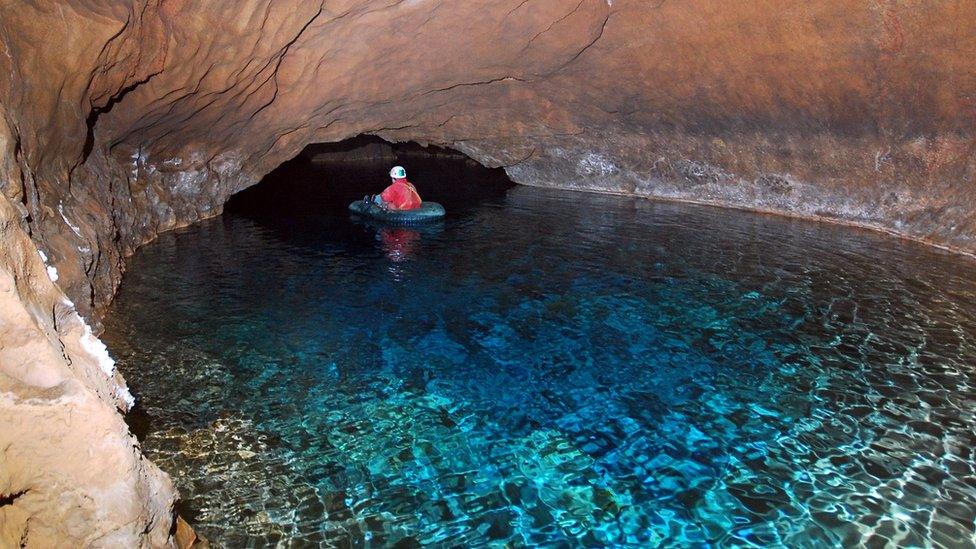Thailand cave rescue: How would you survive in a cave?
- Published

The boys and their coach have been trapped in the Thai cave for days
A desperate search is under way for a group of 12 teenage footballers and their coach who are believed to be trapped deep inside a cave in Thailand.
Heavy rain has flooded the cave system, hindering the authorities' attempts to go in and find them.
The hope is that the group have found a safe, high place to await rescue, but unlike professional cavers, they were not equipped for a long stay.
We spoke to cavers about what you need to do to survive when trapped underground.
They emphasised the need to keep warm and hydrated, and stay out of danger.
What to do if you're trapped
Anmar Mirza, national co-ordinator of the US National Cave Rescue Commission, says the first thing to do is make sure you're not in any immediate danger. Rockfalls pose a risk, but the major worry is flooding.
"You want to seek the highest point in the cave," Mr Mirza said. His advice is to try to guess where water had risen to in previous floods. "There's a number of ways to determine that point - look for mud, leaves, wet slime on the walls."

Rockfalls can be a risk in caves
Then, you want to check what supplies you have with you.
Depending on how long you are in the cave, you may be forced to ration food, water, and even light.
Keep warm
The first major risk, Mr Mirza says, is hypothermia.
"Wring out clothes to keep them dry," he says, "and huddle together for warmth."
Andy Eavis, retired head of the British Caving Association, says thankfully hypothermia probably won't be a big issue in the Thai cave system.
"The ambient temperatures will be fairly high," he says, estimating them to be between 23-26C (73-79F).

Rescuers have been trying to pump the water out of the caves
Mr Eavis, 70, has been exploring caves for the past 50 years, including some in Thailand, Myanmar and China - although not the cave system in which the teenagers and their coach are trapped.
He says many of these caves are huge - some big enough to be explored "with aeroplanes" - and doesn't think they're likely to flood to the roof.
"If they're sitting out of the water, they won't die of hypothermia," he says.
Mr Eavis describes being trapped in a cave in the Pyrenees with two other cavers, where the water was about 2C (36F).
"We were there for 55 hours," he said. "But thankfully, we were wearing wetsuits."
Water
After warmth, Mr Mirza says, the next major concern is water.
"Keep yourself hydrated, but beware of dirty water in the cave," Mr Mirza says. "It's a balancing act - diarrhoea and vomiting would make dehydration a bigger problem later."
Even if the water is dirty, it won't pose an immediate problem, says Mr Eavis. "Most cave waters are reasonably drinkable," he says. "It might cause upset tummies though."

Flooding can pose a serious risk in caves
Bill Whitehouse, retired chairman of the British Cave Rescue Council, recommends looking around the cave.
"Little drips and inlets may have fresher water," he says. "But long term, food will be the problem."
Mr Mirza agrees. "If you have food, make sure not to eat it all at once."
Air
Oxygen is also a factor. However, all three men agree that this isn't as big a concern as you'd think.
"Most caves naturally breathe," Mr Mirza says. "Air can get in and out where people can't."
Carbon dioxide levels can rise if people are trapped in such a small space for so long. But for the most part, the rescuers agree lack of air isn't a major problem.
"In general, it's not uncommon for oxygen levels to be slightly low in caves," says Mr Whitehouse. "But not seriously low. It depends on the cave."
Mental strain
You may have all the supplies to survive, but keeping calm in the dark can be difficult.
"I always tell people it's a marmite sport," says Mr Whitehouse. "Underground is one of those places you're either happy or you're not."
"Don't panic," says Mr Eavis. "Panicking and trying to get out come what may is the biggest risk."

Rescuers have been trying to find another way into the cave
For the Thai teenagers, a lot of pressure will be on whoever is in charge to stop them from trying to dive into the waters, which could be dangerous.
"The leader will have to really control them to stop them doing anything silly, like dive in," he said.
"It's mentally very taxing being in the dark."
Mr Mirza says lighting is not as problematic as it once was.
"Experienced cavers will have hundreds of hours of light with them - modern LEDs, lithium batteries."
But in the case of the teenagers in Thailand, it could be an issue.
"We're not talking about cavers here. They're probably not well equipped," says Mr Whitehouse.

Modern LED torches mean lighting is not as big a problem as it once was
General advice?
As a rule, if you're going to enter a cave, you should always be prepared, Mr Whitehouse says.
"Get the right information, get the right kit, and go with someone who knows the cave," he says.
The veteran cave rescuer also says a vital point is to tell someone where you are going before you go.
"The earlier we get the callout the sooner something can be done," he says.
- Published27 June 2018

- Published27 June 2018
